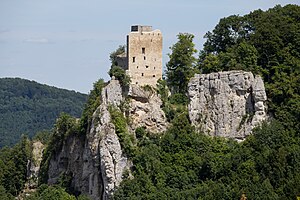Reußenstein ruins
| Reußenstein ruins | ||
|---|---|---|
|
View from the southwest of the Reußenstein ruins |
||
| Creation time : | 1270 | |
| Castle type : | Höhenburg, rocky location | |
| Conservation status: | ruin | |
| Standing position : | Ministeriale | |
| Place: | Envious people | |
| Geographical location | 48 ° 33 '41 " N , 9 ° 34' 2" E | |
| Height: | 760 m above sea level NN | |
|
|
||
The Reußenstein ruin is the ruin of a rock castle above Neidlingen exactly on the border between the Esslingen and Göppingen districts (town of Wiesensteig ) in Baden-Württemberg . Today the Reußenstein is a popular destination for climbers and hikers and is one of the most visited castles in the Alb. The Baden-Württemberg Monument Foundation declared the Reußenstein ruins to be Monument of the Month for December 2012 .
Geographical location
The ruin lies at a height of 760 meters above sea level. Located on a rocky reef on the Albtrauf , it offers a beautiful view of the Neidlinger Tal .
history
The castle was against 1270 as Ministerialburg the rule Teck built; until the late Middle Ages it controlled the only ascent of the Alb from the Neidlinger valley.
Knight Diethoh von Kirchheim-Stein was the first lord of the castle from around 1301. His son sold them to his cousins, Konrad and Heinrich Reuss.
The castle was first called Reußenstein in 1371. Over the next 50 years the castle went to eleven owners. 1381 also to the people of Württemberg. In 1441 the Counts of Helfenstein came into possession of the castle. The last count who lived at the castle was Ludwig Helferich von Reußenstein .
When the Helfensteiners died out in 1550, the castle remained uninhabited and began to crumble. In 1752 the Reußenstein became the property of the Bavarian Court Chamber . In 1806 it became the Württemberg state domain . In 1835 the King of Württemberg donated the castle to his adjutant, Colonel von Fleischmann. In 1846, the allegedly penultimate lynx in Germany was shot near the ruins .
In March 1862, the Hofkammer (then Hofdomänenkammer) bought the castle ruins and the associated large estate from Major General v. Fleischmann for 73,000 guilders. On October 4, 1888, the Hofdomänenkammer auctioned Nikolaus Aierle's share of the Ziegelhof, which borders the Reußenstein domain, for 18,000 guilders. A little later, Julius Aierle acquired the rest of the property for 18,500 guilders. The brick yard was mostly leased together with the Reußenstein domain.
The following tenants managed the goods:
- Johannes Eberhardt, Mehrstetten, Oberamt Münsingen (1862–1877)
- Wilhelm Rall, Jacob's son, Dettingen unter Teck (1877–1901)
- Wilhelm Rall (Ziegelhof) (1901–1904)
- Wilhelm Rall jun. (Ziegelhof) (1904–1915)
- Friedrich Kober, Pfullingen (1901–1915)
- Friedrich Kober and Jakob Kober (1915–1925)
- Jakob Kober (Ziegelhof) (1925–1937)
- Jakob Schilling, Böhringen (1925–1950)
In 1928 a water pipe with a pumping station was set up. In the course of the land reform, the Reußenstein and Ziegelhof domains were expropriated in 1950. On October 5, 1964, the ruin was sold to the Nürtingen district. In 1965/66, the Nürtingen district (now Esslingen district ) and the Swabian Alb Association renovated the Reußenstein under the supervision of the Württemberg Monument Office. In 2012 the south wall was renovated.
On June 13, 2010, a motor sailor crashed into a steep face at the castle ruins and smashed; two people were killed.
description
The late Staufer castle had a main , pre- and lower castle, an approximately 19-meter-high castle keep with 2 meter thick walls on an area of 5.66 times 5.95 meters, on the north side of an extension with pitched roof stood a palace with shield wall like , high front wall and a castle chapel in the courtyard. The shield wall was 14 meters high and 2 meters thick.
Legend by Wilhelm Hauff
According to the legend written by Wilhelm Hauff , the giant Heim vom Heimenstein, who until then had lived in the rock cave in the Schwammstotzen of the same name on the opposite side of the valley, had the castle built on the Reußenstein. To get to the Reußenstein rock, he first had to cross the valley with one big step, but stepped too short and got stuck with one foot in the boggy valley floor. When he pulled it out again, a spring rose from the footstep hole, by which he had created the Lindach by the way .
Finally, a nail was missing from the almost finished castle. However, none of the craftsmen dared to knock it down high. Then a young journeyman came from the Neidling valley who wanted to take the risk. The giant held the young man with his mighty fist out the window over the abyss until he had finished his work. As a reward, he received wealth and Master's daughter as a wife.
gallery
literature
- Karsten Preßler: Built on rock by the “giant home”: for the repair of the Reußenstein ruins . In: Preservation of monuments in Baden-Württemberg . ISSN 0342-0027 . 43 (2014), issue 2, pp. 119–125. Digital edition .
- Günter Schmitt : Castle Guide Swabian Alb, Volume 4 - Alb Mitte-Nord: Hiking and discovering between Aichelberg and Reutlingen . Biberacher Verlagsdruckerei, Biberach an der Riß 1991, ISBN 3-924489-58-0 , pp. 35-46.
Web links
- Reußenstein ruins
- Wilhelm Hauff: The legend of the giant home
- Reconstruction drawing by Wolfgang Braun
- Entry on the Reußenstein ruin in the private database "Alle Burgen".
- 3D model of Reußenstein Castle
Individual evidence
- ^ Hermann Baumhauer: Baden-Württemberg, image of a cultural landscape, Verlag Theiss, 1983, page 116.
- ^ Frank Hohlfeld: Hiking on the Swabian Alb, DuMont active, 35 tours, 2007, page 103.
- ↑ Renovation work 2012
- ^ Plane crash near Stuttgart. Two dead. In: t-online-Nachrichten of June 13, 2010 .















